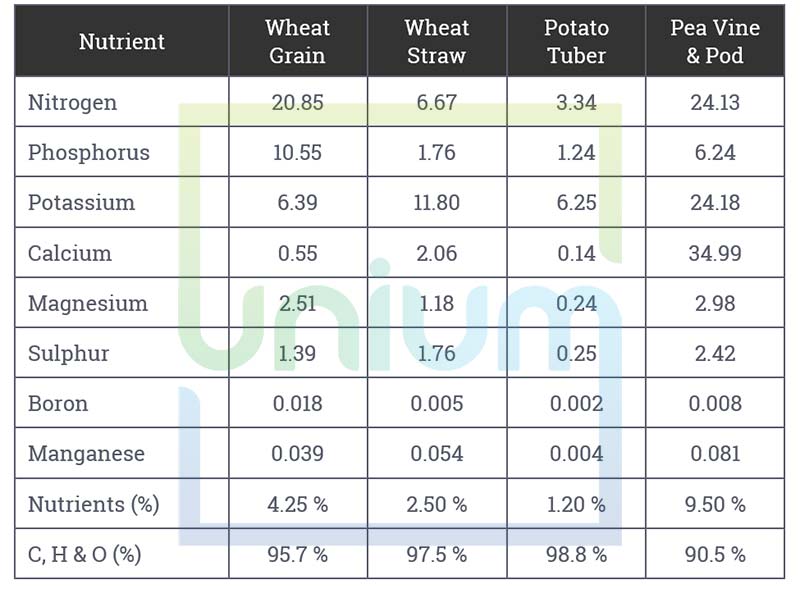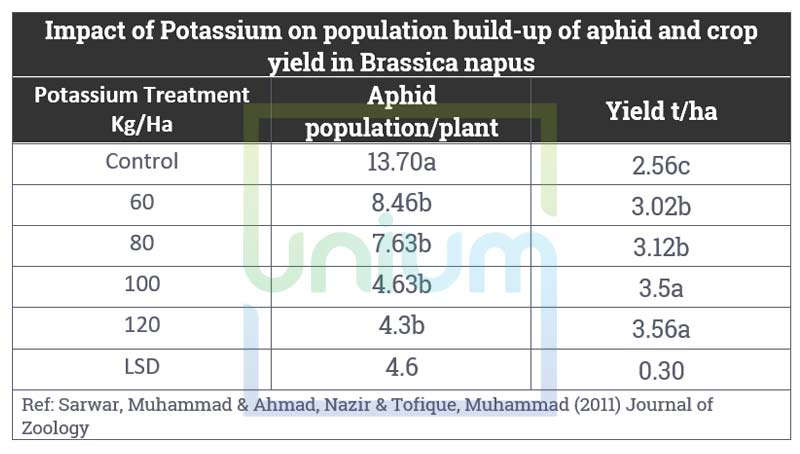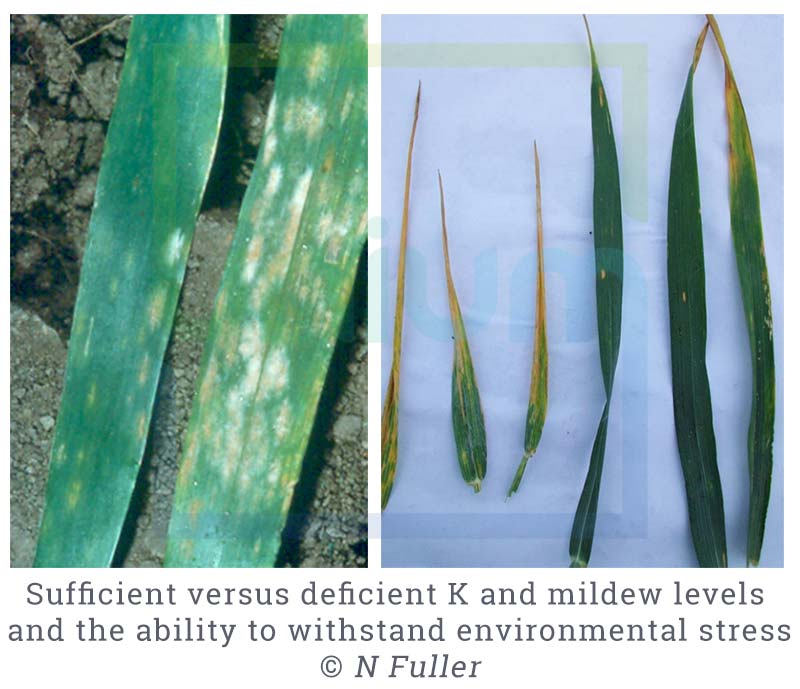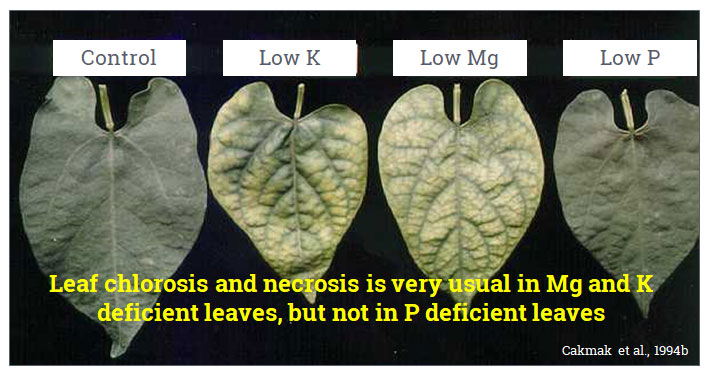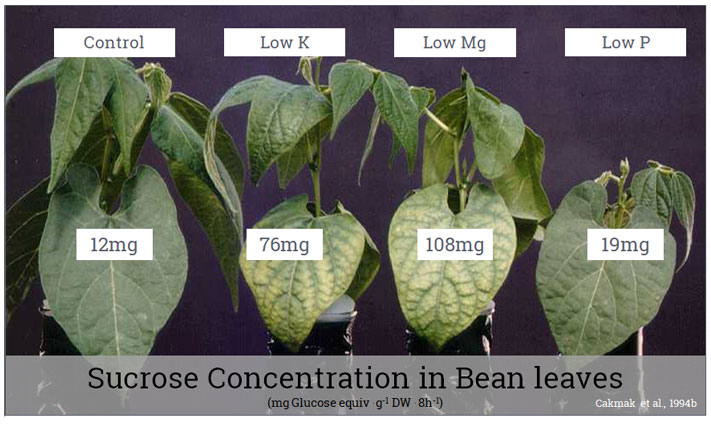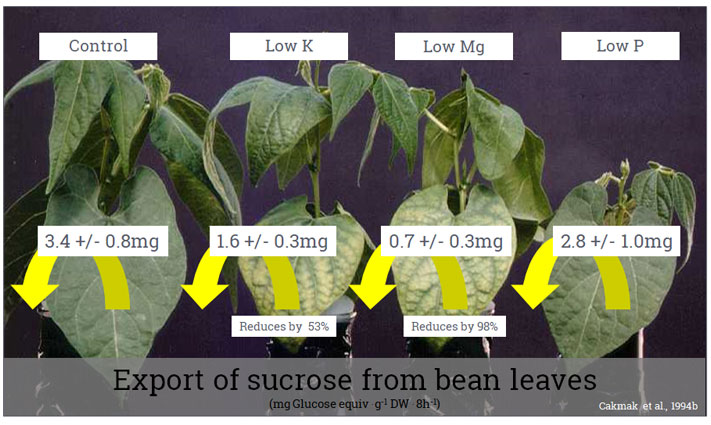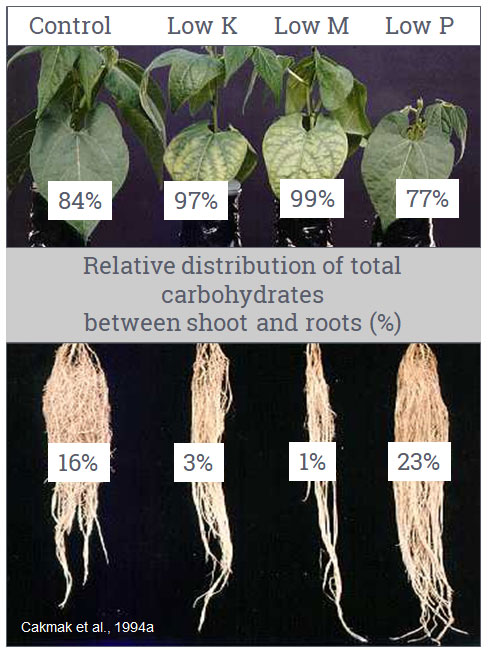- Potassium plays a key role in a crops defence mechanism to help it withstand pest or pathogen attack.
- Deficiency or transient deficiency in a season will make the crop more susceptible to pest attack and infections e.g. BYDV and foliar diseases
- Ensure crop sufficiency with a foliar application of Wholly K at 1.0 l/ha to mitigate these effects.
Plants need access to over 42 different soil minerals, in varying quantities, in order to produce healthy growth.
However, over 95% of the crop composition is Carbon, Hydrogen and Oxygen with less than 5% in minerals, but they are none the less vital for growth, health, reproduction and life. Here are a few figures showing the minerals for wheat, potatoes and peas.
Potassium, taken up as cationic K+, is essential for carbohydrate metabolism, cell division and turgor and also has a role as an electrolyte, regulating Ca, N and Na uptake. It is important for both vegetative as well as reproductive growth.
Potassium fertilisation
- Soil reserves of Potassium are usually high, reflecting clay & organic matter.
- K is mobile in alkaline, low clay and low OM soils.
- Cultivation can displace exchangeable K.
- Peak K demand is from stem extension to the end of flowering & throughout tuber growth.
- Apply K to match crop demand & avoid losses as less than 40% of applied K is recovered by the crop. This suggests for a winter wheat crop receiving 60 kg/ha only 20-25 Kg of K will be recovered.
- K is best applied with Nitrogen & Sulphur.
It is not as mobile in the soil as nitrogen but is a lot more mobile than phosphorus, moving 25mm within 25-40 days and 100mm in 80-180 days.
In the soil, Potassium mobility decreases as Magnesium and pH levels increase and conversely as Potassium levels increase the plant uptake of Magnesium, Boron and Calcium can decrease. As Potassium levels increase within the plant the demand for Nitrogen, Manganese and Iron increase as they work synergistically.
Potassium promotes water uptake, carbohydrate building and dry matter accumulation, affecting grain/tuber size and quality for storage/processing.
Potassium uptake is linked to Phosphorous, Magnesium, Nitrogen and Zinc and a low Potassium status can reduce disease resistance and increase tuber bruising.
It is the increased susceptibility to disease and insect pressure we want to focus on. In the latest PDA newsletter (Potash News October 2020) they cover the use of potassium to mitigate crop damage due to insects, to which you can add disease as well – it’s a complex mode of action particularly linked to amino acids and sugar concentrations.
When potassium levels are restricted for various reasons – soil levels, pH, weather, varietal use-efficiencies etc – then these concentrations can increase Nitrogen-based amino acids, especially after a fertiliser application.
When K uptake is restricted, there are increased levels of sugar accumulation in the leaves and possibly the signals given out from a potassium deficient crop could attract insects. Both could play a key role in the spread of BYDV and disease.
Sufficient availability of potassium by its association with other nutrients, such as Boron and Calcium, strengthen the plant structure, giving a thicker hard surface which is more difficult for the pest or disease to penetrate.
When you consider the rates above in the table to have these positive effects, but that only 40% of applied K is used by plants then the effective Potassium increases are in increments of 8kg/ha between treatments (the incremental difference is 20kg/ha between the treatments which equates to 20 x 40% = 8kg) – hence why well-timed, foliar programmes can be a very effective way of delivering K and taking advantage of its subsequent effects.
K has a link with nitrogen utilisation (incorporate any free N into amino acids and proteins). When we consider this link then it became clear to us that there is a need to link potassium with Carbon and Nitrogen balance. This is why Wholly K has the key link molecule 2OXO and PGA built in.
We have been working with Dr. Pat Unkefer (Advance Crop Chemicals) and formally (Retired) of Los Alamos National Laboratory for many years and are proud to have commercialised two of her leading technologies. Pat has spent over 30 years working on plant nitrogen assimilation and carbon sequestration pathways.
After discovering the metabolite 2 Oxoglutaramate (2 OXO), her team has shown that the unique molecule 2 OXO has a profound effect on plant nitrogen metabolism. Dr. Unkefer working alongside Dr. Nigel Grech (Unium Bioscience), and their respective teams, have finally cracked one of the codes when it comes to carbon sequestration and nitrogen assimilation by producing the most effective molecule in the process 2 OXO, which is the actual functional metabolite that plants use to sense N status and regulate Nitrogen. The increased above ground biomass and the even greater increase in root biomass in field grown treated plants are the drivers of increased soil Carbon sequestration provided by 2 OXO.
So how does it work? It works by coordinating 2 of the key vital processes in plants;
- Increasing carbon fixation by up-regulating photosynthesis and
- Increasing nitrogen uptake accompanied by increased N reduction, assimilation, amino acid synthesis and ultimately, growth and yield.
An ideal combination borne out in our trials over the last three years.
It is also reported in the scientific literature that Potassium has a negative effect on the growth and development of biting and sucking pests reducing occurrence populations levels, rate of population growth and net reproductive rates.
Pathogens, on the other hand, often invade tissues using pectolytic enzymes to dissolve the leaf surface. This is strongly inhibited by calcium, showing the strong link between calcium content and disease resistance. These enzymes cause the efflux of potassium from the leaf membrane by increasing permeability, highlighting that disease infection strategies are targeted at reducing leaf potassium. Subsequent infection severity is directly correlated to this measure.
The following work shows the impact of nutrient stresses on the sucrose levels within leaves and supports the theory
- Low leaf Potassium levels induce the movement of sugars from interstitial fluid to the leaf surface.
- Pathogenic microbes use this sugar secretion to trigger germination, promote multiplication rates and locate potential infection sites.
The following study shows the impact of both low potassium and low magnesium levels and their respective effects on sucrose levels within the plant.
The above picture shows how different nutrient deficiencies can manifest themselves and make the plant more attractive to insects and pathogens.
The above picture shows the massive increase in sucrose levels in the deficient leaves which results in increased exudate potential onto the leaf surface and nutrient provision for pests and diseases.
The above picture you can see the massive reduction of sucrose relocation within the plant to growth areas in a low K or low Mg situation.
The concluding picture shows the relative distribution of carbohydrates between the root and shoot, with low K and/or low Mg dramatically reducing root exudation and carbohydrate supply for the root biome which has a subsequent knock-on effect on plant performance. Are we robbing the root biome to feed to foliar pathogen biome?
We are moving into a world of consequences and considerations and away from a binary decision processes. By understanding the links (wherever possible) we are better able to join the dots, provide better solutions and maximize crop performance.
Fingers crossed we get a settled spell of weather to allow plantings to progress as desired.


